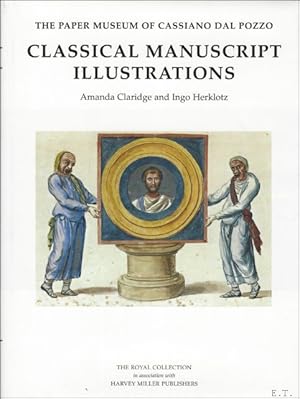A CLARIDGE, I HERKLOTZ (2 risultati)
Tipo di articolo
- Tutti gli articoli
- Libri (2)
- Riviste e Giornali
- Fumetti
- Spartiti
- Arte, Stampe e Poster
- Fotografie
- Mappe
-
Manoscritti e
Collezionismo cartaceo
Condizioni
- Tutte
- Nuovi
- Antichi o usati
Legatura
- Tutte
- Rilegato
- Brossura
Ulteriori caratteristiche
- Prima edizione
- Copia autografata
- Sovraccoperta
- Con foto
- No print on demand
Paese del venditore
Valutazione venditore
-
Classical Manuscript Illustrations,
Editore: Turnhout Brepols 2012, 2012
Da: BOOKSELLER - ERIK TONEN BOOKS, Antwerpen, Belgio
Membro dell'associazione: ILAB
Hardback, 424 p., 46 b/w ill. + 224 colour ill., 22 x 28,5. FINE ISBN 9781905375769. The Paper Museum ('Museo Cartaceo') is a collection of some 10,000 drawings and prints assembled during the seventeenth century by the Roman patron and collector, Cassiano dal Pozzo, and his younger brother, Carlo Antonio. It represents one of the most significant attempts before the age of photography to embrace human knowledge in visual form, documenting ancient art and culture, architecture and topography, natural history and social customs. The 160 drawings catalogued in this volume are derived from five ancient manuscripts: the famous Vatican Vergil, the so-called 'Roman' Vergil, the Vatican Terence, and the less well-known Palatine Agrimensores, all in the Vatican Library, and from a fifth codex, now lost, known as the Chronography or Calendar of the year 354. The bulk of the drawings were copied for Cassiano between 1632 and 1634 for the purpose of studying both the characters depicted and the allied evidence of ancient costume and artefacts. By the later seventeenth century, when Pietro Santi Bartoli executed the last group of drawings in the present volume for Carlo Antonio, manuscript illustrations had come to be cherished as much for their rarity as examples of ancient painting as for their documentary value. Introductory essays provide an overview of the dal Pozzo commissions, the manuscripts and their history down to Cassiano's day, as well as their study in the wider context of classical scholarship through to the eighteenth century. All the drawings are reproduced in colour at full page, with accompanying descriptions of the subjects or relevant ancient verses in modern translation and brief commentaries. Languages : English. 0 g.
-
Classical Manuscript Illustrations
Editore: Miller-brepols 2012, 2012
Da: BOOKSELLER - ERIK TONEN BOOKS, Antwerpen, Belgio
Membro dell'associazione: ILAB
Hardback with dusjacket in fine condition !!, Languages: English, 413pp. illustration in color. ISBN 9781905375769. The Paper Museum (?Museo Cartaceo?) is a collection of some 10,000 drawings and prints assembled during the seventeenth century by the Roman patron and collector, Cassiano dal Pozzo, and his younger brother, Carlo Antonio. It represents one of the most significant attempts before the age of photography to embrace human knowledge in visual form, documenting ancient art and culture, architecture and topography, natural history and social customs.The 160 drawings catalogued in this volume are derived from five ancient manuscripts: the famous Vatican Vergil, the so-called ?Roman? Vergil, the Vatican Terence, and the less well-known Palatine Agrimensores, all in the Vatican Library, and from a fifth codex, now lost, known as the Chronography or Calendar of the year 354. The bulk of the drawings were copied for Cassiano between 1632 and 1634 for the purpose of studying both the characters depicted and the allied evidence of ancient costume and artefacts. By the later seventeenth century, when Pietro Santi Bartoli executed the last group of drawings in the present volume for Carlo Antonio, manuscript illustrations had come to be cherished as much for their rarity as examples of ancient painting as for their documentary value. Introductory essays provide an overview of the dal Pozzo commissions, the manuscripts and their history down to Cassiano?s day, as well as their study in the wider context of classical scholarship through to the eighteenth century. All the drawings are reproduced in colour at full page, with accompanying descriptions of the subjects or relevant ancient verses in modern translation and brief commentaries. 0 g.



